2014 FORD MONDEO check
[x] Cancel search: checkPage 140 of 446
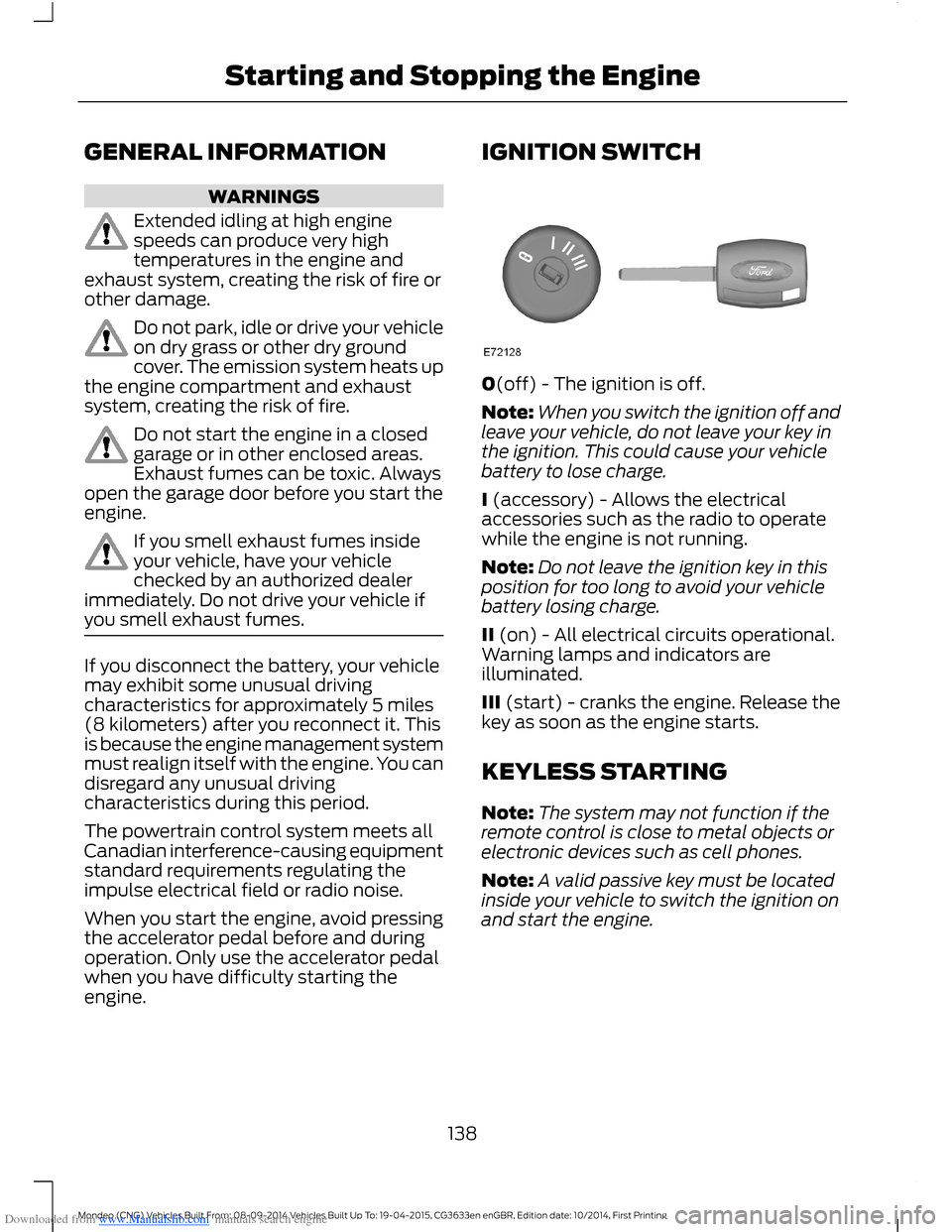
Downloaded from www.Manualslib.com manuals search engine GENERAL INFORMATION
WARNINGS
Extended idling at high enginespeeds can produce very hightemperatures in the engine andexhaust system, creating the risk of fire orother damage.
Do not park, idle or drive your vehicleon dry grass or other dry groundcover. The emission system heats upthe engine compartment and exhaustsystem, creating the risk of fire.
Do not start the engine in a closedgarage or in other enclosed areas.Exhaust fumes can be toxic. Alwaysopen the garage door before you start theengine.
If you smell exhaust fumes insideyour vehicle, have your vehiclechecked by an authorized dealerimmediately. Do not drive your vehicle ifyou smell exhaust fumes.
If you disconnect the battery, your vehiclemay exhibit some unusual drivingcharacteristics for approximately 5 miles(8 kilometers) after you reconnect it. Thisis because the engine management systemmust realign itself with the engine. You candisregard any unusual drivingcharacteristics during this period.
The powertrain control system meets allCanadian interference-causing equipmentstandard requirements regulating theimpulse electrical field or radio noise.
When you start the engine, avoid pressingthe accelerator pedal before and duringoperation. Only use the accelerator pedalwhen you have difficulty starting theengine.
IGNITION SWITCH
0(off) - The ignition is off.
Note:When you switch the ignition off andleave your vehicle, do not leave your key inthe ignition. This could cause your vehiclebattery to lose charge.
I (accessory) - Allows the electricalaccessories such as the radio to operatewhile the engine is not running.
Note:Do not leave the ignition key in thisposition for too long to avoid your vehiclebattery losing charge.
II (on) - All electrical circuits operational.Warning lamps and indicators areilluminated.
III (start) - cranks the engine. Release thekey as soon as the engine starts.
KEYLESS STARTING
Note:The system may not function if theremote control is close to metal objects orelectronic devices such as cell phones.
Note:A valid passive key must be locatedinside your vehicle to switch the ignition onand start the engine.
138Mondeo (CNG) Vehicles Built From: 08-09-2014 Vehicles Built Up To: 19-04-2015, CG3633en enGBR, Edition date: 10/2014, First PrintingStarting and Stopping the Engine
Page 141 of 446
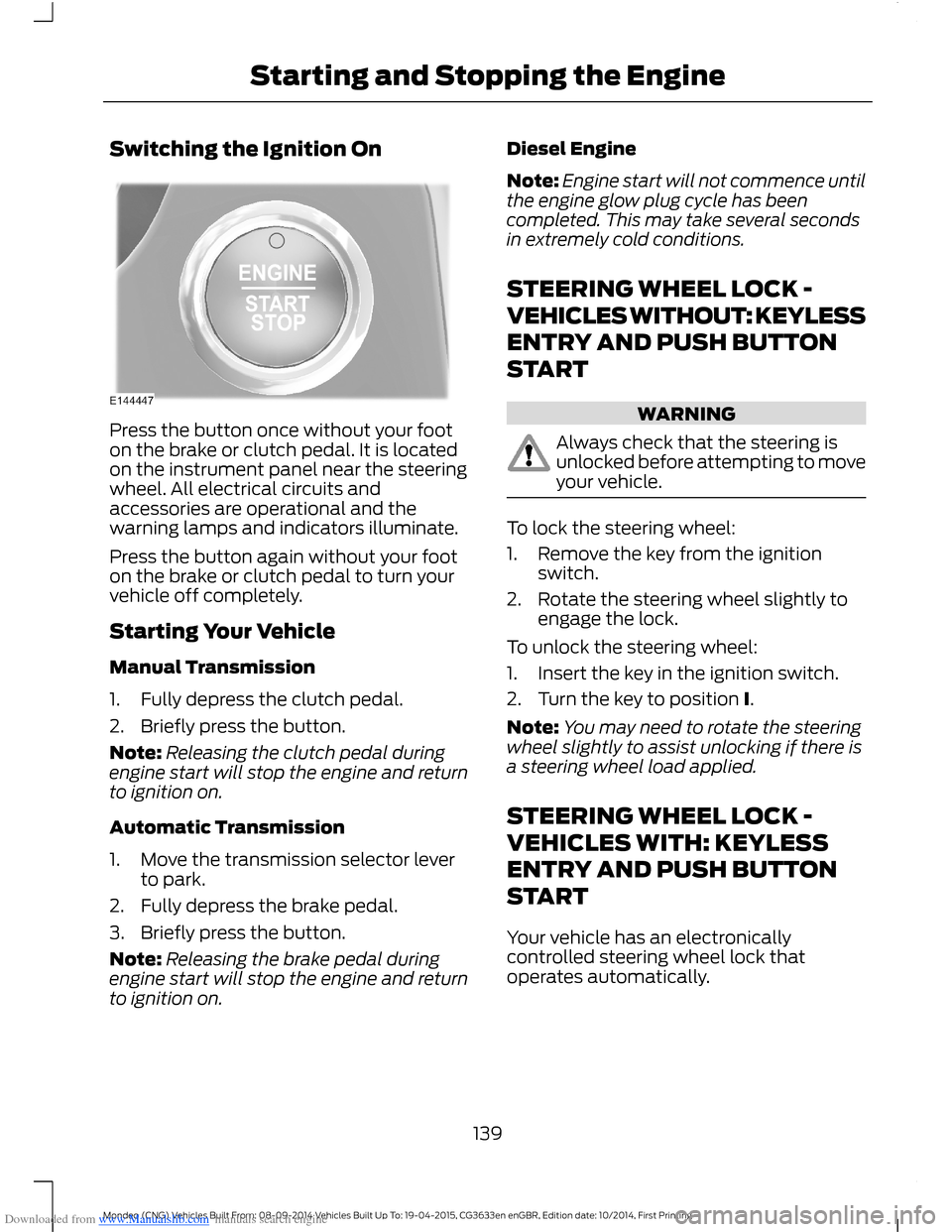
Downloaded from www.Manualslib.com manuals search engine Switching the Ignition On
Press the button once without your footon the brake or clutch pedal. It is locatedon the instrument panel near the steeringwheel. All electrical circuits andaccessories are operational and thewarning lamps and indicators illuminate.
Press the button again without your footon the brake or clutch pedal to turn yourvehicle off completely.
Starting Your Vehicle
Manual Transmission
1.Fully depress the clutch pedal.
2.Briefly press the button.
Note:Releasing the clutch pedal duringengine start will stop the engine and returnto ignition on.
Automatic Transmission
1.Move the transmission selector leverto park.
2.Fully depress the brake pedal.
3.Briefly press the button.
Note:Releasing the brake pedal duringengine start will stop the engine and returnto ignition on.
Diesel Engine
Note:Engine start will not commence untilthe engine glow plug cycle has beencompleted. This may take several secondsin extremely cold conditions.
STEERING WHEEL LOCK -
VEHICLES WITHOUT: KEYLESS
ENTRY AND PUSH BUTTON
START
WARNING
Always check that the steering isunlocked before attempting to moveyour vehicle.
To lock the steering wheel:
1.Remove the key from the ignitionswitch.
2.Rotate the steering wheel slightly toengage the lock.
To unlock the steering wheel:
1.Insert the key in the ignition switch.
2.Turn the key to position I.
Note:You may need to rotate the steeringwheel slightly to assist unlocking if there isa steering wheel load applied.
STEERING WHEEL LOCK -
VEHICLES WITH: KEYLESS
ENTRY AND PUSH BUTTON
START
Your vehicle has an electronicallycontrolled steering wheel lock thatoperates automatically.
139Mondeo (CNG) Vehicles Built From: 08-09-2014 Vehicles Built Up To: 19-04-2015, CG3633en enGBR, Edition date: 10/2014, First PrintingStarting and Stopping the Engine
Page 142 of 446
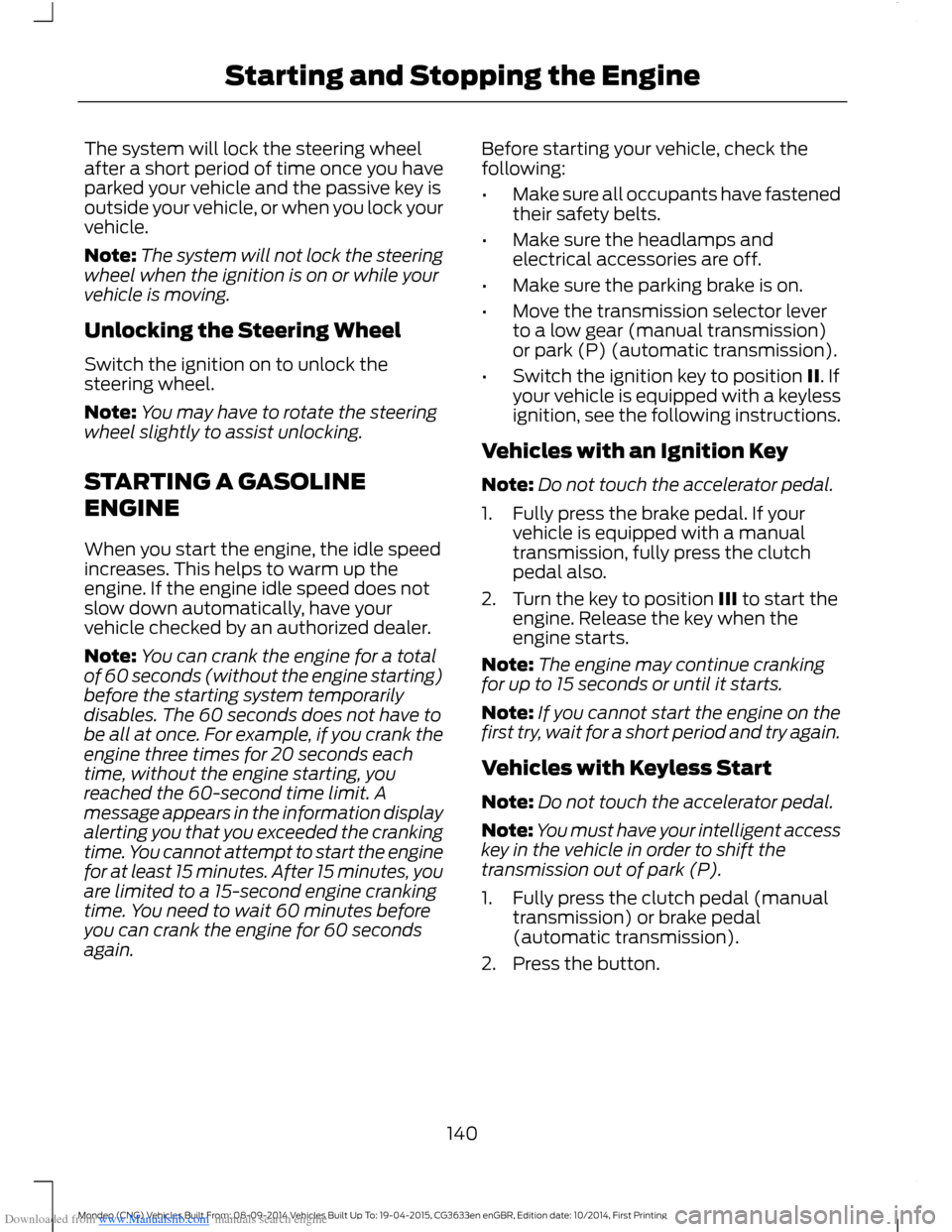
Downloaded from www.Manualslib.com manuals search engine The system will lock the steering wheelafter a short period of time once you haveparked your vehicle and the passive key isoutside your vehicle, or when you lock yourvehicle.
Note:The system will not lock the steeringwheel when the ignition is on or while yourvehicle is moving.
Unlocking the Steering Wheel
Switch the ignition on to unlock thesteering wheel.
Note:You may have to rotate the steeringwheel slightly to assist unlocking.
STARTING A GASOLINE
ENGINE
When you start the engine, the idle speedincreases. This helps to warm up theengine. If the engine idle speed does notslow down automatically, have yourvehicle checked by an authorized dealer.
Note:You can crank the engine for a totalof 60 seconds (without the engine starting)before the starting system temporarilydisables. The 60 seconds does not have tobe all at once. For example, if you crank theengine three times for 20 seconds eachtime, without the engine starting, youreached the 60-second time limit. Amessage appears in the information displayalerting you that you exceeded the crankingtime. You cannot attempt to start the enginefor at least 15 minutes. After 15 minutes, youare limited to a 15-second engine crankingtime. You need to wait 60 minutes beforeyou can crank the engine for 60 secondsagain.
Before starting your vehicle, check thefollowing:
•Make sure all occupants have fastenedtheir safety belts.
•Make sure the headlamps andelectrical accessories are off.
•Make sure the parking brake is on.
•Move the transmission selector leverto a low gear (manual transmission)or park (P) (automatic transmission).
•Switch the ignition key to position II. Ifyour vehicle is equipped with a keylessignition, see the following instructions.
Vehicles with an Ignition Key
Note:Do not touch the accelerator pedal.
1.Fully press the brake pedal. If yourvehicle is equipped with a manualtransmission, fully press the clutchpedal also.
2.Turn the key to position III to start theengine. Release the key when theengine starts.
Note:The engine may continue crankingfor up to 15 seconds or until it starts.
Note:If you cannot start the engine on thefirst try, wait for a short period and try again.
Vehicles with Keyless Start
Note:Do not touch the accelerator pedal.
Note:You must have your intelligent accesskey in the vehicle in order to shift thetransmission out of park (P).
1.Fully press the clutch pedal (manualtransmission) or brake pedal(automatic transmission).
2.Press the button.
140Mondeo (CNG) Vehicles Built From: 08-09-2014 Vehicles Built Up To: 19-04-2015, CG3633en enGBR, Edition date: 10/2014, First PrintingStarting and Stopping the Engine
Page 145 of 446

Downloaded from www.Manualslib.com manuals search engine Guarding Against Exhaust Fumes
WARNING
If you smell exhaust fumes insideyour vehicle, have your vehiclechecked by your authorized dealerimmediately. Do not drive your vehicle ifyou smell exhaust fumes. Carbonmonoxide is present in exhaust fumes.Take precautions to avoid its dangerouseffects.
Important Ventilating Information
If you stop your vehicle and then leave theengine idling for long periods, werecommend that you do one of thefollowing:
•Open the windows at least 1.0 in(2.5 cm).
•Set your climate control to outside air.
STARTING A DIESEL ENGINE
Cold or Hot Engine
1.Switch the ignition on and wait untilthe glow plug indicator goes off.
2.Fully depress the clutch pedal (manualtransmission) or brake pedal(automatic transmission).
3.Start the engine.
Note:Do not touch the accelerator pedal.
Note:Releasing the clutch pedal (manualtransmission) or brake pedal (automatictransmission) while the engine is startingwill stop the engine cranking and return toignition on.
Note:When the temperature is below 5°F(-15°C), you may need to crank the enginefor up to 10 seconds.
Note:You can only operate the starter fora limited period of time.
Note:After a limited number of attemptsto start your engine, the system does notallow you to try again until a period of timehas elapsed, for example 30 minutes.
Failure to Start
If the engine does not crank when theclutch pedal has been fully depressed andthe ignition key is turned to position III.
1.Fully depress the clutch and brakepedals.
2.Turn the key to position III until theengine starts.
DIESEL PARTICULATE FILTER
The filter forms part of the emissionsreduction system on your vehicle. It filtersharmful diesel particulates (soot) from theexhaust gas.
Regeneration
WARNING
Do not park or idle your vehicle overdry leaves, dry grass or othercombustible materials. Theregeneration process creates very highexhaust gas temperatures and the exhaustwill radiate a considerable amount of heatduring and after regeneration and after youhave switched the engine off. This is apotential fire hazard.
Note:Avoid running out of fuel.
Note:During regeneration at low speed orengine idle, you may smell a hot metallicodor and could notice a clicking metallicsound. This is due to the high temperaturesreached during regeneration and is normal.
143Mondeo (CNG) Vehicles Built From: 08-09-2014 Vehicles Built Up To: 19-04-2015, CG3633en enGBR, Edition date: 10/2014, First PrintingStarting and Stopping the Engine
Page 147 of 446

Downloaded from www.Manualslib.com manuals search engine We recommend that you do the followingfor a safe and correct operation:
•Use an extension cord suitable for useoutdoors and in cold temperatures. Itshould be clearly marked that it issuitable for use with outdoorappliances. Do not use an indoorextension cord outdoors. This couldresult in an electric shock or become afire hazard.
•Use as short an extension cord aspossible.
•Do not use multiple extension cords.
•Make sure that when in operation, theextension cord plug and heater cordplug connections are free and clear ofwater. This could cause an electricshock or fire.
•Make sure you park your vehicle in aclean area, clear of combustibles.
•Make sure you firmly connect theheater, heater cord and extension cord.
•Check for heat anywhere in theelectrical hookup when the system hasbeen operating for approximately 30minutes.
•Make sure you unplug and correctlystow the system before starting anddriving your vehicle. Make sure theprotective cover seals the prongs of theblock heater cord plug when not in use.
•Make sure you check the heater systemfor correct operation before winter.
Using the Engine Block Heater
The engine block heater plug is located ina housing in the left fog lamp bezel. Openthe hinged, circular door and make surethe receptacle terminals are clean and dryprior to use. Clean them with a dry cloth ifnecessary.
The heater uses 0.4 to 1.0 kilowatt-hoursof energy per hour of use. The system doesnot have a thermostat. It achievesmaximum temperature afterapproximately three hours of operation.Using the heater longer than three hoursdoes not improve system performance andunnecessarily uses electricity.
145Mondeo (CNG) Vehicles Built From: 08-09-2014 Vehicles Built Up To: 19-04-2015, CG3633en enGBR, Edition date: 10/2014, First PrintingStarting and Stopping the Engine
Page 149 of 446
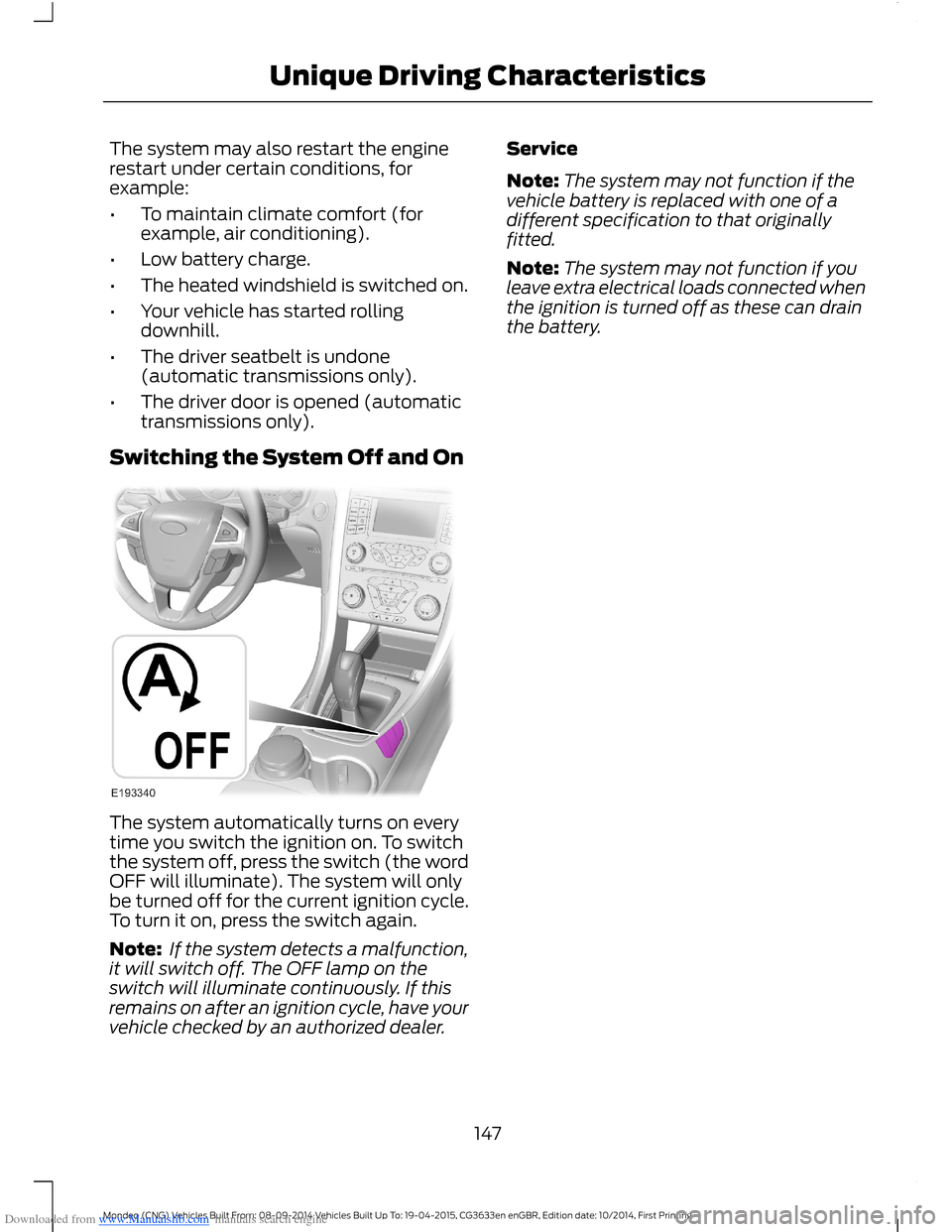
Downloaded from www.Manualslib.com manuals search engine The system may also restart the enginerestart under certain conditions, forexample:
•To maintain climate comfort (forexample, air conditioning).
•Low battery charge.
•The heated windshield is switched on.
•Your vehicle has started rollingdownhill.
•The driver seatbelt is undone(automatic transmissions only).
•The driver door is opened (automatictransmissions only).
Switching the System Off and On
The system automatically turns on everytime you switch the ignition on. To switchthe system off, press the switch (the wordOFF will illuminate). The system will onlybe turned off for the current ignition cycle.To turn it on, press the switch again.
Note: If the system detects a malfunction,it will switch off. The OFF lamp on theswitch will illuminate continuously. If thisremains on after an ignition cycle, have yourvehicle checked by an authorized dealer.
Service
Note:The system may not function if thevehicle battery is replaced with one of adifferent specification to that originallyfitted.
Note:The system may not function if youleave extra electrical loads connected whenthe ignition is turned off as these can drainthe battery.
147Mondeo (CNG) Vehicles Built From: 08-09-2014 Vehicles Built Up To: 19-04-2015, CG3633en enGBR, Edition date: 10/2014, First PrintingUnique Driving Characteristics
Page 154 of 446
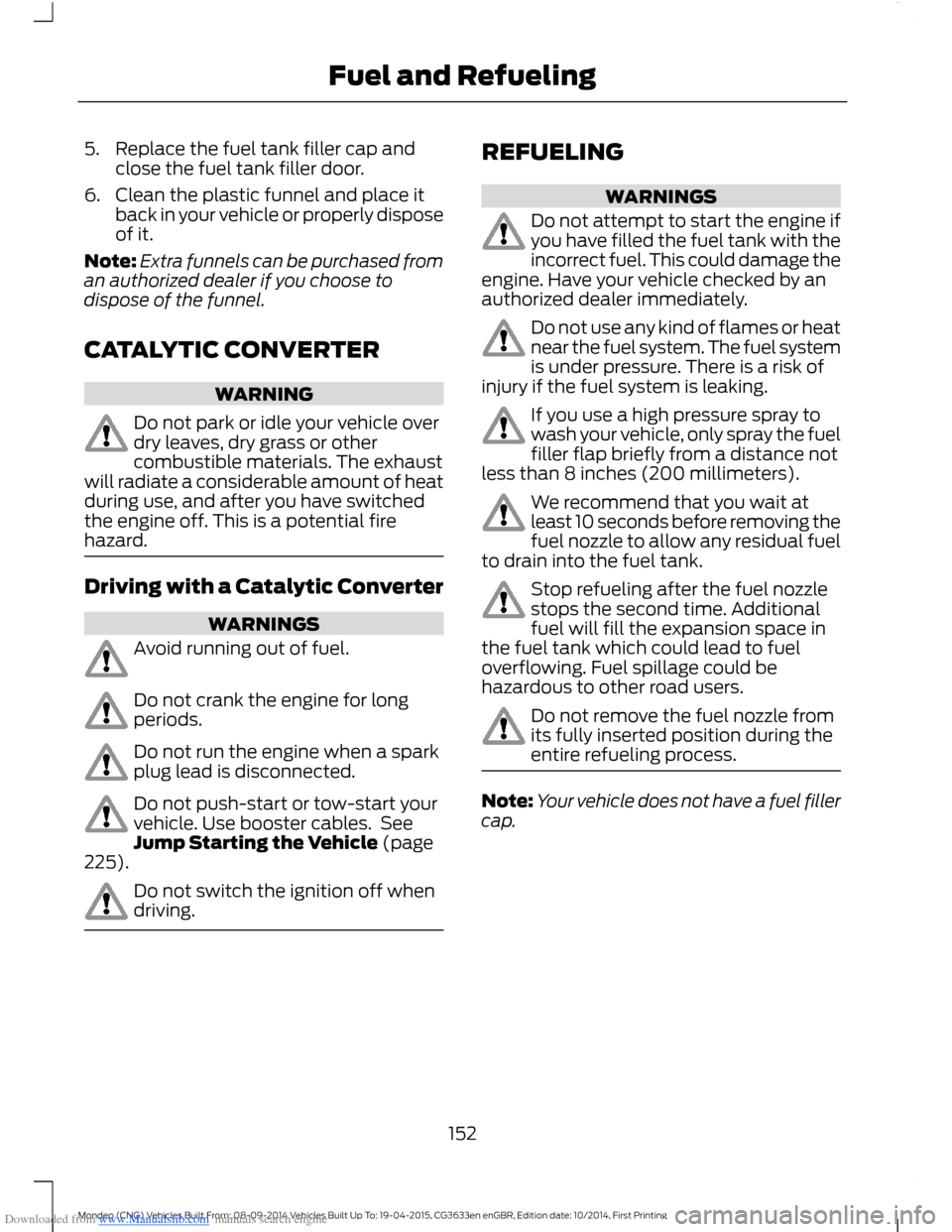
Downloaded from www.Manualslib.com manuals search engine 5.Replace the fuel tank filler cap andclose the fuel tank filler door.
6.Clean the plastic funnel and place itback in your vehicle or properly disposeof it.
Note:Extra funnels can be purchased froman authorized dealer if you choose todispose of the funnel.
CATALYTIC CONVERTER
WARNING
Do not park or idle your vehicle overdry leaves, dry grass or othercombustible materials. The exhaustwill radiate a considerable amount of heatduring use, and after you have switchedthe engine off. This is a potential firehazard.
Driving with a Catalytic Converter
WARNINGS
Avoid running out of fuel.
Do not crank the engine for longperiods.
Do not run the engine when a sparkplug lead is disconnected.
Do not push-start or tow-start yourvehicle. Use booster cables. SeeJump Starting the Vehicle (page225).
Do not switch the ignition off whendriving.
REFUELING
WARNINGS
Do not attempt to start the engine ifyou have filled the fuel tank with theincorrect fuel. This could damage theengine. Have your vehicle checked by anauthorized dealer immediately.
Do not use any kind of flames or heatnear the fuel system. The fuel systemis under pressure. There is a risk ofinjury if the fuel system is leaking.
If you use a high pressure spray towash your vehicle, only spray the fuelfiller flap briefly from a distance notless than 8 inches (200 millimeters).
We recommend that you wait atleast 10 seconds before removing thefuel nozzle to allow any residual fuelto drain into the fuel tank.
Stop refueling after the fuel nozzlestops the second time. Additionalfuel will fill the expansion space inthe fuel tank which could lead to fueloverflowing. Fuel spillage could behazardous to other road users.
Do not remove the fuel nozzle fromits fully inserted position during theentire refueling process.
Note:Your vehicle does not have a fuel fillercap.
152Mondeo (CNG) Vehicles Built From: 08-09-2014 Vehicles Built Up To: 19-04-2015, CG3633en enGBR, Edition date: 10/2014, First PrintingFuel and Refueling
Page 162 of 446
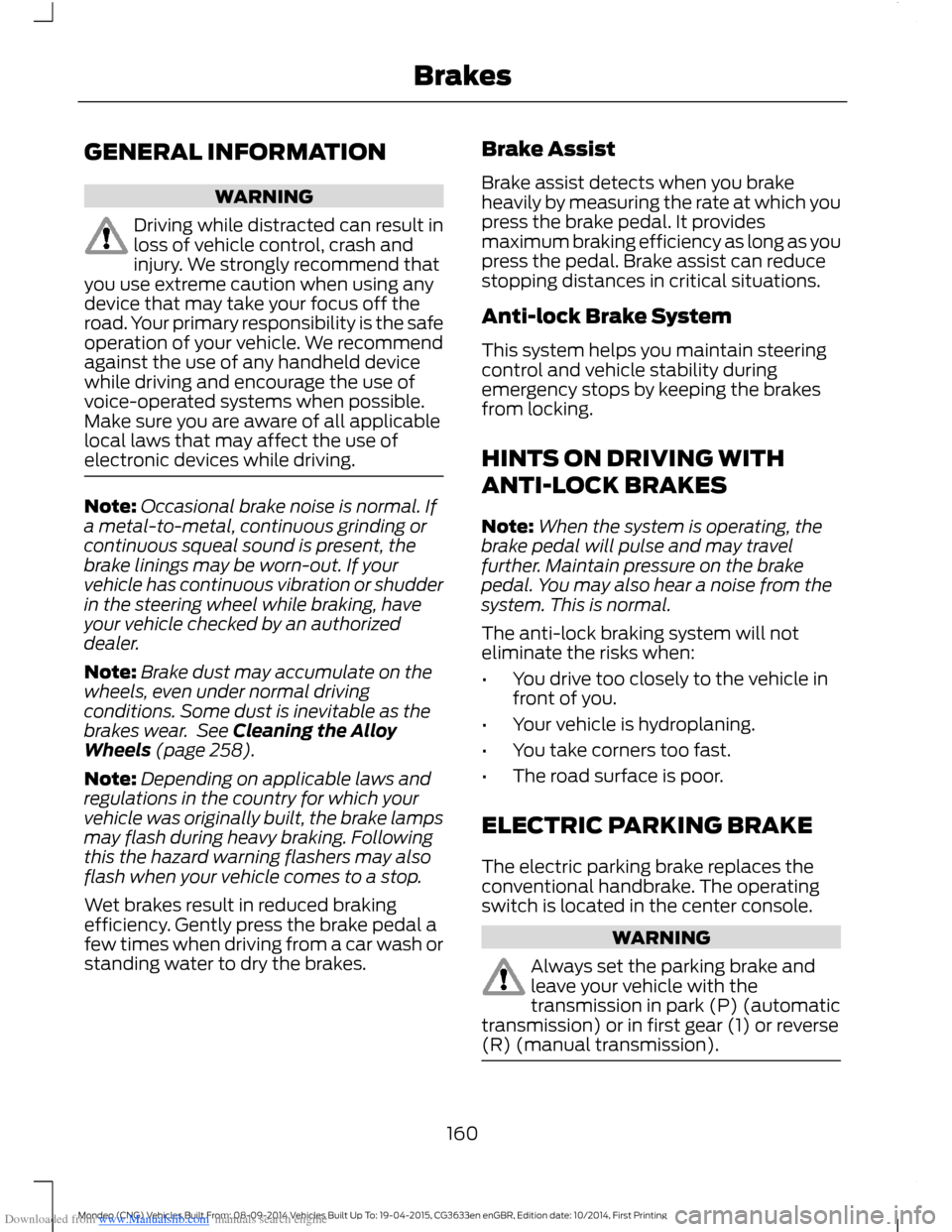
Downloaded from www.Manualslib.com manuals search engine GENERAL INFORMATION
WARNING
Driving while distracted can result inloss of vehicle control, crash andinjury. We strongly recommend thatyou use extreme caution when using anydevice that may take your focus off theroad. Your primary responsibility is the safeoperation of your vehicle. We recommendagainst the use of any handheld devicewhile driving and encourage the use ofvoice-operated systems when possible.Make sure you are aware of all applicablelocal laws that may affect the use ofelectronic devices while driving.
Note:Occasional brake noise is normal. Ifa metal-to-metal, continuous grinding orcontinuous squeal sound is present, thebrake linings may be worn-out. If yourvehicle has continuous vibration or shudderin the steering wheel while braking, haveyour vehicle checked by an authorizeddealer.
Note:Brake dust may accumulate on thewheels, even under normal drivingconditions. Some dust is inevitable as thebrakes wear. See Cleaning the AlloyWheels (page 258).
Note:Depending on applicable laws andregulations in the country for which yourvehicle was originally built, the brake lampsmay flash during heavy braking. Followingthis the hazard warning flashers may alsoflash when your vehicle comes to a stop.
Wet brakes result in reduced brakingefficiency. Gently press the brake pedal afew times when driving from a car wash orstanding water to dry the brakes.
Brake Assist
Brake assist detects when you brakeheavily by measuring the rate at which youpress the brake pedal. It providesmaximum braking efficiency as long as youpress the pedal. Brake assist can reducestopping distances in critical situations.
Anti-lock Brake System
This system helps you maintain steeringcontrol and vehicle stability duringemergency stops by keeping the brakesfrom locking.
HINTS ON DRIVING WITH
ANTI-LOCK BRAKES
Note:When the system is operating, thebrake pedal will pulse and may travelfurther. Maintain pressure on the brakepedal. You may also hear a noise from thesystem. This is normal.
The anti-lock braking system will noteliminate the risks when:
•You drive too closely to the vehicle infront of you.
•Your vehicle is hydroplaning.
•You take corners too fast.
•The road surface is poor.
ELECTRIC PARKING BRAKE
The electric parking brake replaces theconventional handbrake. The operatingswitch is located in the center console.
WARNING
Always set the parking brake andleave your vehicle with thetransmission in park (P) (automatictransmission) or in first gear (1) or reverse(R) (manual transmission).
160Mondeo (CNG) Vehicles Built From: 08-09-2014 Vehicles Built Up To: 19-04-2015, CG3633en enGBR, Edition date: 10/2014, First PrintingBrakes